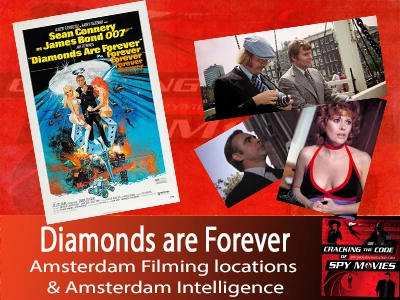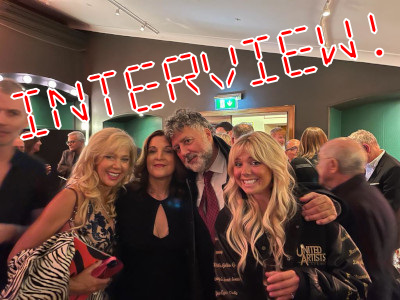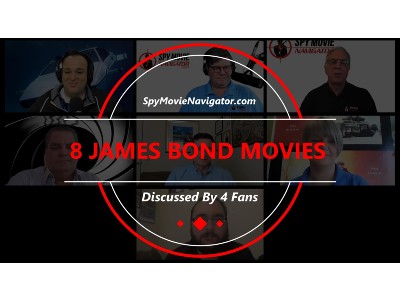HOW EVENTS IN THE REAL-WORLD AFFECT WHAT GOES INTO SPY FILMS – Part 1
Have you ever thought about how events in the real world and other movies could affect and work their way into some of our favorite spy movies? Well, think about it a minute because that’s what we are going to explore today on Spy Movie Navigator. (MUSIC)
Hi, this is Dan Silvestri and Tom Pizzato at Spy Movie Navigator.com – the Worldwide Community of Spy Movie Fans – Spy Movie podcasts, videos, discussions and more!
Let’s start by looking at some of the Bond films – the biggest success franchise in all of spy films and a few others.
The first real fact is, of course, Ian Fleming got the name James Bond from one of his favorite books, Birds of the West Indies, by…. James Bond.
Dr. No was written in 1957 by Ian Fleming, published in 1958, and was his 6th James Bond novel. The movie Dr. No, EON Production’s first Bond movie, came out in 1962. So, here is the first instance the real world affecting this spy movie:
- By 1962, both the Soviet Union and the USA were launching astronauts into space, so far ahead of the theme in the novel where the USA was launching test missiles. In the novel, Dr. No says he is working with the Russians to disrupt American test missiles, in the movie, he is disrupting American space flights. Also, in the movie both the East and the West have rejected his services, and so he is a member of SPECTRE ( Special Executive for Counter-Intelligence, Terrorism, Revenge and Extortion), and not working with the Russians. The cold war between Russia (the Soviet Union) and the US in real life was heating up by the time the movie came out, so here, the movie was influenced by real world happenings.
- And, in a subtle nod to life happening, the painting of the Duke of Wellington by Francisco de Goya was stolen August 21st, 1961 from the National Gallery in London. It was still missing when EON Productions was filming Dr. No. So, In Dr. No, when Bond is in Dr. No’s lair, he walks through the lair about to step up a couple of steps, stops and looks at a painting on an easel – it is the Duke of Wellington! So, if you are watching Dr. No and don’t realize the painting he stops to look at is this real-life stolen Duke of Wellington, you just think, ah Bond finds that painting interesting. Once you know the real–life incident, then this adds a brilliant glow to this scene, where the writers for EON Productions were indeed very clever and inventive. By the way, the painting was eventually recovered in real-life and now hangs in Gallery A at the National Gallery in London once again – we saw it there while visiting Gallery # 24 where in SPECTRE, Bond meets the new Q.
From Russia With Love – 1963 – released in 1963 by EON Productions as their second James Bond film, and Ian Fleming’s 5th James Bond novel published in 1957 (the year the Soviets launched Sputnik, the first man-made satellite), was heavily influenced by the times – and the Cold War. The tensions between the US and the Soviets was at an all-time high. Remember, the Cuban Missile Crisis (the showdown between Russia and the US) was in October 1962, the year EON was filming From Russia With Love. So, once again, EON Productions was brilliant in their release of From Russia With Love!
- In addition, check out the book, “For Your Eyes Only – Ian Fleming + James Bond” by Ben Macintyre. Here he tells of the attempt to murder Bond on the Orient Express by SMERSH was based on a US Naval attaché in Romania, Eugene Karp, who was more than likely trying to escape from Russian agents. He boarded the Orient Express in Bucharest in February 1950, and his body was found in a railway tunnel near Salzburg. It was never proven the Soviet assassins did it, but it is highly probable.
- Even SMERSH is from the Russian Smyert Shpionam = “death to spies” – and we will see this is The Living Daylights.
Goldfinger – 1964 released in 1964 by EON Productions as their third James Bond film, based on Ian Fleming’s 7th novel of the same name, published in 1959. In the pre-title sequence in the movie (not written in the novel) is James Bond in a wet/dry suit emerging from the water, setting explosives, and then removing his wetsuit (really a dry suit) to reveal a perfectly neat and crisp white dinner jacket, bow tie etc. Ah, you are thinking like we were thinking – what is the chance of that really happening or being able to happen?!
Well, let’s talk to MI6 about a similar WW-II operation! In an article by David Harrison in April 2010 for The Telegraph, he reveals that a Jeremy Duns, a British writer, was researching a new book. He found out that a Dutch spy used a very similar technique to infiltrate a German-occupied mansion in the Netherlands during WW-II. From the water, he emerged in a wetsuit. Underneath this specially designed wetsuit, he wore the evening wear. His evening wear would make him look like he belonged, and he could slip past the guards into the party. He was supposed to extract two comrades and escape. Well, Jeremy Duns thinks that a Brit screenwriter, Paul Dehn, who was called in to polish up the Goldfinger script, knew about this WW-II incident, because he was a former intelligence officer in WW-II. Hmm! The original script did not have this scene, and, as said, it was not in the novel. He feels it is too much of a coincidence that this scene was written into the screenplay by Paul Dehn, who most certainly was aware of this WW-II operation! True real-life incident put into the movie!
Skipping ahead, at the point in the film where Bond is captured by Goldfinger’s henchmen after another great car chase scene, Bond finds himself strapped to a metal table, as Goldfinger is about to demonstrate his new toy – a laser beam. Here in the film, the laser beam is directed at the base of the table and is guided to rise-up between Bond’s legs, into his crotch and eventually kill him. In the book by Fleming, published March 23 1959, there were no lasers yet – and so this device was a table saw. The laser was not invented until 1960. The first working laser was built on May 16, 1960 by Theodore H. Maiman at Hughes Research Laboratories based on the theoretical work of Charles Hard Townes and Arthur Leonard Schawlow. The term laser came to be an acronym for “Light Amplification by Stimulated Emission of Radiation.” Again, EON Productions was brilliant at integrating a real-life happening, the invention of the laser, into this film which was being shot in 1963 for release in 1964. And at the time, this was a very high-tech scene in Goldfinger! We cannot think of another film of any kind using a laser before Goldfinger, so here is another first for EON Productions!
This scene is famous the world-over for the laser, and for the dialogue: Bond: “ You expect me to talk?” Goldfinger” “No, Mr. Bond I expect you to die!”
Thunderball – 1965 Thunderball was Ian Fleming’s 9th James Bond novel, published in 1961, and EON Production’s 4th James Bond 007 movie, which opened in 1965. Thunderball probably would have been the first movie produced but there were some copyright issues that were delayed in settlement. Kevin McClory and Fleming had worked on a script that never made it to production. Fleming used part of it for Thunderball, and eventually a settlement was reached. Thunderball is the only early EON production movie where the producers are not listed as “Cubby” Broccoli and Harry Saltzman. Here they are listed as Executive Producers (which is a lesser status) and McClory is listed as the producer. Also, McClory got the right to produce his own James Bond film based on his Thunderball contributions and eventually did Never Say Never Again which is basically the same story.
But we digress! In Thunderball, SPECTRE is at it again. So, we get away from the US versus the Soviet Union and have this other entity as the enemy again. Remember in Dr. No we were introduced to SPECTRE.
Of course, by 1961 when the novel was published, we had lots of atomic bombs in the world, and there was an arms race between the Soviet Union and the US. So, atomic weapons were on everyone’s minds.
- The basis of this story is based in real life – people were worried about a nuclear war and atomic weapons. Here, two atomic weapons are hijacked by SPECTRE who threaten to destroy a major city either in the US or in the United Kingdom. So even though EON Productions did not make this their first Bond film, in 1965 the world was very aware of the threat from major powers building up supplies of nuclear weapons. So, the topic was hot.
- The sky hook, which recovers Bond and Domino at the end, is an actual real-life device developed by Robert Fulton for the CIA in the 1950s. By letting up a line from the ground with a self-inflating balloon, a specially equipped plane can fly by and scoop up the line and the one or two personnel it was designed to retrieve. Cool! A real-life gadget at the time.
- In 1956, a Soviet cruiser came to Britain, with Nikita Khrushchev on a state visit to Britain. He was the former Premiere of the Soviet Union. It was also in 1956 where, Khrushchev said: “We will bury you” while addressing Western ambassadors at a reception at the Polish embassy in Moscow on November 18, 1956. So Soviet/Western relations were not good. So on this visit to Britain, Britain wanted to get a look at this new Soviet ship – some reports say to examine for mine-laying hatches, or sonar equipment, and other reports, like from Peter Wright’s book, “Spycatcher,” Britain’s Naval Intelligence wanted information on the potential new propeller system this ship had. So MI6 sent a scuba diver down (actually, two were reported as being sent) and one was a great diver, Lionel Crabb. Crabb never returned from this mission, and a headless, handless body was found 14 months later dressed in the scuba gear he had worn on that date (April 15 1956). MI6 covered up the mission, saying Crabb was lost in some underwater exercise. Many theories floated about, one being that Soviet sentries were stationed underwater to guard the ship, caught Crabb, cut his air hose and brought him aboard and he later died. Other theories say he was shot underwater by a Soviet sniper.
Now, you will remember in Thunderball, Bond is sent to inspect the hull of the Disco Volante, Largo the villain’s boat. Bond is discovered too by Largos frogmen, as Bond was taking photos of the hull to determine if there was an underwater hatch. Bond, more luck than Crabb, escapes. The photos showed an underwater hatch which leeds Bond to think Largo’s entire operation (the theft of the plane carrying to nuclear missiles) might be underwater – including the plane that was hijacked. Is there a connection between the Crabb event and these scenes in Thunderball? The MI6 officer in charge of the Lionel Crabb underwater deployment and mission was Nicholas Elliott – a friend of Fleming’s!
- In the 1958 movie, Silent Enemy, (based on a true story) – 2 British battleships are sunk in Alexandria by explosives set under their hulls. The explosives, in real life, were being set by Italian scuba-divers, who were launched from a submarine using what they called, “underwater chariots” – which in Thunderball and other spy movies to come – were the underwater sleds used to transport the bombs, get divers to certain locations underwater, etc.! In real life, they were using these underwater chariots to bring frogmen to the British ships where they would attach torpedoes and mines. The British had to figure this out and stop it – and here, Lionel Crabb (who we mentioned earlier) was in charge of the operation to infiltrate the enemy ship, destroy their capabilities of continuing to blow up British ships! So, in this movie we see real-life events. Of course, we see in The Spy Who Loved Me, Stromberg’s (the villain) ship, the “Liparus,” has underwater bow hatches that capture the Soviet and US submarines (with nuclear weapons aboard).
In the same movie, Silent Enemy, ALSO, there is a great underwater battle of frogmen, cutting breathing hoses and more – just like in Thunderball and additional spy movies to come. The Thunderball underwater scenes, filmed in the Bahamas, were set the standard for future underwater battles, and the potential connections to real-life events from World War 2 makes Thunderball underwater hull investigations, and underwater battles with frogmen and underwater sleds even more grounded in reality.
Also in Thunderball, the jet pack, was real and flown by Bill Suiter, who demanded using a helmet which is why Sean Connery as Bond puts on a helmet when he takes off.
- Though the movie came out in 1965, Fleming’s 9th novel was published in 1961. And it foreshadowed the threat of the Cuban Missile Crisis to the US Florida cities (like Miami, Cape Canaveral etc).
You Only Live Twice – 1967 Ian Fleming’s 12th novel published in 1964 (counting the For Your Eyes Only collection of short stories, and it’s the last novel published before his death), and EON Production’s 5th James Bond 007 film which opened in 1967. The movie has little to do with the actual novel. Here, the beginning of the movie depicts the death of James Bond, complete with obituary in the newspapers. There is a burial at sea for Commander Bond, and when the body sinks to the bottom of the ocean, scuba divers retrieve the body and bring it to the awaiting submarine where it is taken aboard, the wrappings open, only to reveal a live James Bond who quips, “Request permission to come aboard, Sir.”
Thank God Bond is alive – we were worried, right? His death was faked to throw off the enemy . Of course, that means they knew who James Bond was, which is often the case, but that’s another podcast!
- The faked death of spies is definitely grounded in reality. Google Arkady Babchenko, faked his own death because being very critical of Vladimir Putin, he was certain that he would be killed by the KGB. In a huge real-life situation in World War-II, Operation Mincemeat (Google it!) the Allies floated the body of a dead man with fake papers identifying him as a Captain who the Germans had been tracking. With papers indicating an invasion of Sardinia Italy and Greece instead of Sicily, to mislead the Germans. Some stories say the fictitious name of the dead man was Captain William Martin, while other reports say the Germans were aware of the supposed dead man and felt he really knew something. Regardless, the deception worked. And the source of the plan came from Rear Admiral John Godfrey and his assistant, Lieutenant Commander Ian Fleming. Yep!
- We all remember Henderson, the contact Bond meets in Japan and who has key information, was based on Richard Hughes, a reporter and double agent who worked for Ian Fleming at one point during WW-II. Hughes did a lot of Bond-like things. Hughes spent a great deal of time in Japan. Hence, a great place to film this movie. Google The extraordinary untold Japan story of ‘You Only Live Twice’ by Damian Flanigan, special to the Japan Times. Great story!
- “Little Nellie,” the one-man autogyro that Bond flies to do surveillance in Japan was a real-life invention, developed by Ken Wallis, a Royal Air Force guy, in the early part of the 1960s. The one used in the movie was modified, of course.
- Of course, the Space Race played a part here too – the US and Soviet Union at the time were racing each other for outer space advantages and achievements. So, SPECTRE capturing Soviet and US space capsules is a natural, given the times in 1967, two years before Neil Armstrong and Buzz Aldrin will land on the moon on the US Apollo 11.
On Her Majesty’s Secret Service – 1969 Ian Fleming’s 11th novel, published in 1963; and EON Production’s 6th James Bond 007 movie, showing in 1969. The first Bond movies without Sean Connery, George Lazenby steps in to be Bond and to be bonded – married – to Teresa Di Vincenzo (Tracy) – played by Diana Rigg.
In his mountain-top laboratory, posing as an allergy clinic, at Piz Gloria (Schilthorn, Switzerland Blofeld is brainwashing young women to deliver a chemical agent that will stop plants and animals from reproducing- creating a tremendous food crisis. The setting is spectacular – we have been to Piz Gloria about 10,000 feet up!
- In 1968, there was an experiment done by the US Army at Dugway Proving Grounds in Utah. Through a malfunction of a spraying nozzle, a toxic chemical was released and almost 30 miles away, over 6,000 sheep were found dead. There was no definitive connection to the agent released and the sheep deaths, but traces of the toxic chemical were supposedly found on the carcasses. So, draw your own conclusion! So, when OHMSS comes out in 1969, chemical warfare and potential devastation to life through chemicals was very much real.
- The Soviet Union was ramping up chemical warfare research, while the US began to downgrade ours. Again, what Blofeld was thinking was not out of the realm of possibility!




